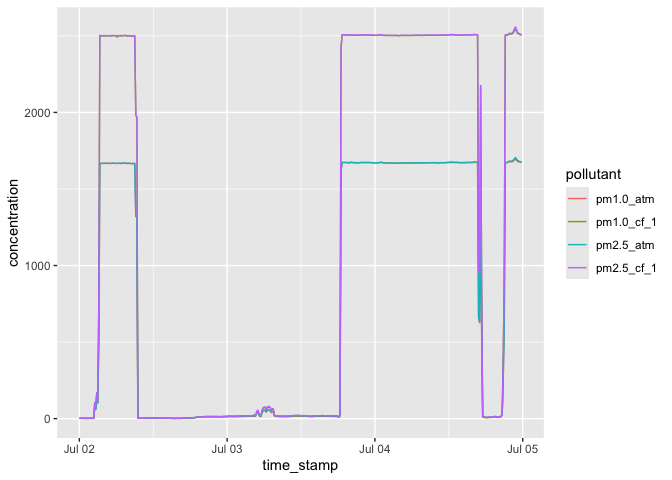Query the 'PurpleAir' Application Programming Interface.
PurpleAir
The goal of PurpleAir is to provide read access to the PurpleAir API to retrieve real-time and historical data from PurpleAir sensors.
Please note that usage of this package must abide by the requirements of the PurpleAir API. From their website:
PurpleAir was founded on principles of openness, sharing, and community. It is to strengthen these principles and ensure the success of our entire community that we put together updated terms of service, data license, and data attribution requirements when using PurpleAir data and this API. Please take a moment to review them and note the attribution guide and data license agreement. If you have any questions or need more information, we have an excellent resource at https://community.purpleair.com/c/data/api/18.
Installation
Install PurpleAir from CRAN with:
install.packages("PurpleAir")
Install the latest development version of PurpleAir from GitHub with:
pak::pak("cole-brokamp/PurpleAir")
Usage
library(PurpleAir)
Querying data from the PurpleAir API requires a free PurpleAir Developer API key linked to a Google account. Functions in the package each take a purple_air_api_key argument or your key can be stored in an environment variable called PURPLE_AIR_API_KEY. To check your key, use:
check_api_key(Sys.getenv("PURPLE_AIR_API_KEY"))
#> ✔ Using valid 'READ' key with version V1.0.14-0.0.58 of the PurpleAir API on 1728410515
Get the latest data from a single PurpleAir sensor, defined by its sensor key:
get_sensor_data(sensor_index = 175413,
fields = c("name", "last_seen", "pm2.5_cf_1", "pm2.5_atm"))
#> $last_seen
#> [1] "2024-10-08 13:59:39 EDT"
#>
#> $name
#> [1] "JN-Clifton,OH"
#>
#> $pm2.5_atm
#> [1] 0.9
#>
#> $pm2.5_cf_1
#> [1] 0.9
Get the latest data from many PurpleAir sensors, defined by their sensor keys,
get_sensors_data(x = c(175257, 175413),
fields = c("name", "last_seen", "pm2.5_cf_1", "pm2.5_atm"))
#> # A tibble: 2 × 5
#> sensor_index last_seen name pm2.5_atm pm2.5_cf_1
#> <int> <dttm> <chr> <dbl> <dbl>
#> 1 175257 2024-10-08 14:00:02 Lillard 1.4 1.4
#> 2 175413 2024-10-08 14:01:39 JN-Clifton,OH 1 1
a geographic bounding box,
sf::st_bbox(
c(
"xmin" = -84.82030,
"ymin" = 39.02153,
"xmax" = -84.25633,
"ymax" = 39.31206
),
crs = 4326
) |>
get_sensors_data(fields = c("name"))
#> # A tibble: 56 × 2
#> sensor_index name
#> <int> <chr>
#> 1 35225 Mt. Washington
#> 2 102568 SR32
#> 3 103282 Carolina pines
#> 4 111898 Bridgetown Sanctuary
#> 5 120311 Loveland
#> 6 127885 Meals on Wheels
#> 7 127915 MSD 6
#> 8 127921 Groundwork
#> 9 130719 NKU KY DAQ
#> 10 156117 Tshs 1
#> # ℹ 46 more rows
or a date from which sensors must have been modified since.
get_sensors_data(as.POSIXct(Sys.time()) - 60, fields = "name")
#> # A tibble: 568 × 2
#> sensor_index name
#> <int> <chr>
#> 1 978 Hillerød f989
#> 2 1294 Roberts Creek
#> 3 1638 Moab
#> 4 2372 SCSB_22
#> 5 2574 Berkeley Park and Coventry, Kensington, CA, USA
#> 6 3088 Howe Neighborhood
#> 7 3277 Shop
#> 8 3497 Olive
#> 9 5538 Hood River Weather
#> 10 6408 Amberwood
#> # ℹ 558 more rows
Get historical data from a single PurpleAir sensor:
my_history <-
get_sensor_history(
sensor_index = 175413,
fields = c("pm1.0_cf_1", "pm1.0_atm", "pm2.5_cf_1", "pm2.5_atm"),
start_timestamp = as.POSIXct("2024-07-02"),
end_timestamp = as.POSIXct("2024-07-05")
)
my_history
#> # A tibble: 432 × 5
#> time_stamp pm1.0_cf_1 pm1.0_atm pm2.5_atm pm2.5_cf_1
#> <dttm> <dbl> <dbl> <dbl> <dbl>
#> 1 2024-07-03 23:40:00 2503. 1670. 1671. 2505.
#> 2 2024-07-04 06:50:00 2504. 1670. 1671. 2505.
#> 3 2024-07-03 22:10:00 2505. 1672. 1673. 2507.
#> 4 2024-07-04 07:10:00 2503. 1670. 1671. 2504.
#> 5 2024-07-04 09:40:00 2504. 1671. 1672. 2505.
#> 6 2024-07-04 11:30:00 2504. 1671. 1673. 2506.
#> 7 2024-07-04 03:40:00 2501. 1668. 1669. 2502.
#> 8 2024-07-03 22:20:00 2504. 1671. 1673. 2506.
#> 9 2024-07-04 03:00:00 2502. 1669. 1669. 2503.
#> 10 2024-07-04 18:50:00 8.32 8.32 10.1 10.1
#> # ℹ 422 more rows
and plot it:
my_history |>
tidyr::pivot_longer(cols = tidyr::starts_with("pm"), names_to = "pollutant", values_to = "concentration") |>
ggplot2::ggplot(ggplot2::aes(time_stamp, concentration, color = pollutant)) +
ggplot2::geom_line()

By default, the PurpleAir R package retries failed API requests related to an underlying HTTP error (e.g., network is down) or a transient API error (i.e., 429, 503). Before retrying each failed request, it waits about 2 seconds. Successive failed requests result in exponentially longer waiting times (httr2::req_retry()). Specify the maximum number of seconds to wait (by default 45) with the environment variable PURPLE_AIR_API_RETRY_MAX_TIME.
